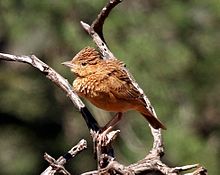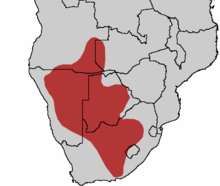The eastern clapper lark (Corypha fasciolata) is a small passerine bird which breeds in southern Africa. It derives its name from the wing clapping which forms part of its display flight.
| Eastern clapper lark | |
|---|---|

| |
| M. f. subsp. fasciolata at Tswalu Kalahari Reserve, South Africa | |
| Scientific classification | |
| Domain: | Eukaryota |
| Kingdom: | Animalia |
| Phylum: | Chordata |
| Class: | Aves |
| Order: | Passeriformes |
| Family: | Alaudidae |
| Genus: | Corypha |
| Species: | C. fasciolata
|
| Binomial name | |
| Corypha fasciolata (Sundevall, 1850)
| |

| |
| resident range | |
| Synonyms | |
| |
Taxonomy and systematics
editThe eastern clapper lark was formerly placed in the genus Mirafra. It is one of several species that were moved to the resurrected genus Corypha based on the results of a large molecular genetic study by the Swedish ornithologist Per Alström and collaborators that was published in 2023.[2][3]
This species and the Cape clapper lark were formerly considered conspecific as the "clapper lark" (M. apiata) until split based on genetic analysis.[2][4] The eastern clapper lark and the Cape clapper lark are regarded as forming a superspecies with the flappet lark (Amirafra rufocinnamomea), which is found further to the north.[5]
Subspecies
editFive subspecies are recognised:[2]
- C. f. reynoldsi (Benson & Irwin, 1965) – north Namibia, north Botswana and southwest Zambia
- C. f. jappi (Traylor, 1962) – west Zambia
- C. f. nata (Smithers, 1955) – northeast Botswana
- C. f. damarensis (Sharpe, 1875) – north, central Namibia and west, central Botswana
- C. f. fasciolata (Sundevall, 1850) – central south Botswana and north, central South Africa
Description
editThis lark is a 15-cm-long bird, with a brown crown, rich rufous underparts, and a strong bill. It has brown upperparts (greyer in the north of its range). Its call is an ascending "pooooeeeee".
Distribution and habitat
editThe eastern clapper lark is found in much of the drier parts of southern Africa in Zambia, Namibia, Botswana, Lesotho and South Africa. It is a species of open grassland and savannah.
Behaviour and ecology
editThe eastern clapper lark is a skulking species, difficult to find when not displaying. It is not gregarious, and individuals tend to be seen in dry habitats feeding on the ground on seeds and insects. The display commences with an ascending flight with wing flapping. It then parachutes down with trailing legs.
References
edit- ^ BirdLife International (2016). "Mirafra fasciolata". IUCN Red List of Threatened Species. 2016: e.T103765243A104188133. doi:10.2305/IUCN.UK.2016-3.RLTS.T103765243A104188133.en. Retrieved 18 November 2021.
- ^ a b c Gill, Frank; Donsker, David; Rasmussen, Pamela, eds. (August 2024). "Nicators, Bearded Reedling, larks". IOC World Bird List Version 14.2. International Ornithologists' Union. Retrieved 10 September 2024.
- ^ Alström, P.; Mohammadi, Z.; Enbody, E.D.; Irestedt, M.; Engelbrecht, D.; Crochet, P.-A.; Guillaumet, A.; Rancilhac, L.; Tieleman, B.I.; Olsson, U.; Donald, P.F.; Stervander, M. (2023). "Systematics of the avian family Alaudidae using multilocus and genomic data". Avian Research. 14: 100095. doi:10.1016/j.avrs.2023.100095.
- ^ Alström, P.; Barnes, K.N.; Olsson, U.; Barker, F.K.; Bloomer, P.; Khan, A.A.; Qureshi, M.A.; Guillaumet, A.; Crochet, P.-A.; Ryan, P.G. (2013). "Multilocus phylogeny of the avian family Alaudidae (larks) reveals complex morphological evolution, non-monophyletic genera and hidden species diversity". Molecular Phylogenetics and Evolution. 69 (3): 1043–1056. doi:10.1016/j.ympev.2013.06.005.
- ^ Keith, Stuart; Urban, Emil K.; Woodcock, Martin; Willis, Ian (2000). The Birds of Africa. Vol. 6: Picathartes to Oxpeckers. Academic Press. ISBN 978-0121373061. OCLC 59539112.
- Sinclair, Hockey and Tarboton, SASOL Birds of Southern Africa, ISBN 1-86872-721-1
